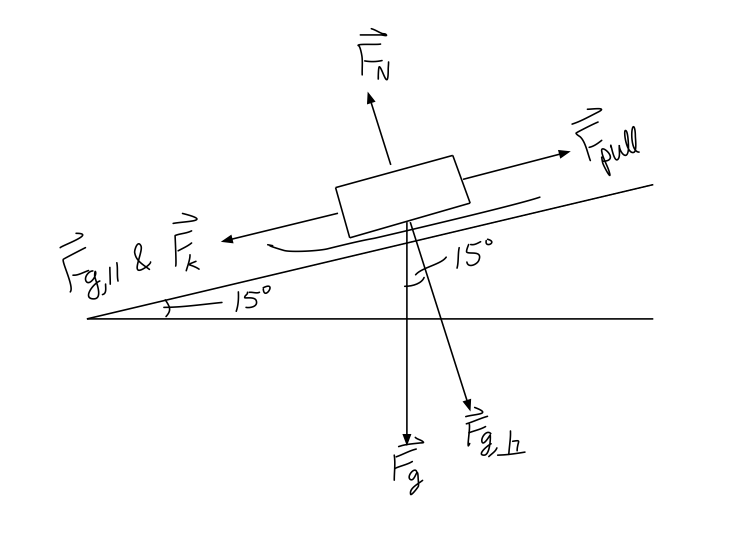A man pulls his child in a sled at a constant velocity. The child and sled have a combined mass of 60 kg. The force applied on the handle is 200N at an angle of 15. Draw a free body diagram. What is the normal force acting on the sled?
What is the force of friction acting on the sled?
What is the force of friction acting on the sled?
1 Answer
With this kind of problem, it's very important that you keep track of your sign conventions. I set the y direction perpendicular (outwards from) to the ramp as positive and x direction parallel down the ramp as negative. Thus,
Here's the free body diagram I came up with (treat the sled and child as one unified object):

Remember that
Therefore, numerically,
#sum_i vecF_(x,i) = -vecF_k + vecF_(pu ll) + mgsintheta = 0#
#sum_i vecF_(y,i) = vecF_N + mgcostheta = 0# where
#vecF_k# is the reacting force of the kinetic friction,#vecF_(pu ll) = "200 N"# is the force used to pull the sled, and#vecF_(g,||) = mgsintheta# is the force component of gravity parallel to the ramp. Note that#veca_x = 0# due to the constant velocity.
The plus and minus signs in the equations are such that the forces numerically oppose each other when they add later on. I know that
You can see we can solve for the normal force right away.
#color(blue)(vecF_N) = -mgcostheta#
#= -("60 kg" xx -"9.81 m/s"^2 xx cos(15^@)) = color(blue)("568.54 N")#
Once we have that, we should recall the definition of the kinetic friction force:
#vecF_k = mu_kvecF_N# ,where
#mu_k# is the coefficient of kinetic friction.
Thus, the coefficient of kinetic friction is acquired like so:
#-vecF_k + vecF_(pu ll) + mgsintheta = 0#
#-vecF_k = -vecF_(pu ll) - mgsintheta = -mu_kvecF_N#
#color(blue)(mu_k) = (vecF_(pu ll) + mgsintheta)/vecF_N#
#= (("200 N") + ("60 kg")(-"9.81 m/s"^2)sin(15^@))/("568.54 N")#
#= color(blue)(0.0838)#
And the force of kinetic friction would be:
#color(blue)(vecF_k) = vecF_(pu ll) + mgsintheta#
#= "200 N" + ("60 kg")(-"9.81 m/s"^2)(sin15^@)#
#=# #color(blue)("47.66 N")#

